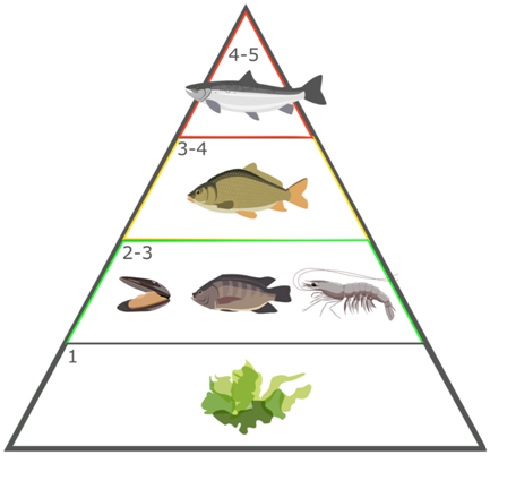FEED-FOOD COMPETITION IN GLOBAL AQUACULTURE
Introduction
Humanity is faced with the challenge of feeding the world’s growing population while staying within the planet’s environmental limits. In this regard, circular food systems offer the potential to achieve this goal.
Circular food systems are based on prioritizing the use of biomass from arable land and water bodies for human food and other basic needs, rather than for feeding animals.
In this new paradigm, farm animals, including aquaculture species, should not consume food that is usable by humans, but convert crop, livestock, and fishery byproducts that are not edible to humans into edible biomass.
Researchers from Wageningen University and Research analyzed the competition between food and feed in aquaculture using two criteria: natural trophic levels (NT) and human-specific edible protein conversion rates (HePCR).
They estimated HePCRs for case studies of four aquaculture species: Atlantic salmon, common carp (Cyprinus carpio), white shrimp (Litopenaeus vannamei) and Nile tilapia (Oreochromis niloticus).

Figure : Overview of natural trophic levels of key aquaculture species. 4–5: Atlantic salmon, 3–4: common carp, 2–3: mussels, Nile tilapia, whiteleg shrimp, 1: Seaweeds. (van Riel et al. (2023)).
Feed-food competition
To date, discussions of feed competition in aquaculture have focused on the use of fishmeal, and for good reason: 9% of the fish catch is processed into fishmeal and fish oil, 90% of which can be considered food grade.
These studies have focused on the fish input-output rate (FIFO) as an indicator of feeding efficiency for aquaculture species. FIFO varies considerably among species.
HePCR
HePCR is equal to the ratio of human edible protein in the feed (input) to human edible protein in the animal produced (output).
To better understand the potential of aquaculture to convert non-human edible by-products into edible biomass, researchers collected and classified aquaculture production data according to natural trophic levels.
HePCRs were calculated for four aquaculture species produced in intensive aquaculture systems: Atlantic salmon, common carp, Nile tilapia and shrimp.
Under current feed use, we estimated that carp, tilapia and shrimp were net contributors of protein, as they require about 0.6 kg of edible protein for humans to produce 1 kg of protein in fillet/meat,” they said.
The use of fish meal and soybean meal, which can be used in human food, in the feeds of aquaculture species increased the HePCR to ~2 and made all species studied net consumers of protein.
Study Summary
“We started with the premise that aquaculture has great potential for food production, avoiding competition between feed and food. We use natural trophic levels as a starting point for analyzing feed competition, as an animal’s natural ability to convert specific by-products into food can determine its role in a circular food system,” they explain.
In both Europe and America, Atlantic salmon was the highest trophic level species (NT 4-5) with the largest and fastest growing production, leading to an increase in the average natural trophic level produced.
“When examining feed competition in the present study, the classification of soybean meal and fishmeal as competing or noncompeting ingredients had a major influence on the net contribution to protein supply of the four aquaculture species,” they report.
When considering human edible ingredients, it is not only the high trophic level species (salmon) that emerge as net consumers of protein, but also the lower trophic level species (common carp, white shrimp, and Nile tilapia), the researchers report.
“When soybean meal and fishmeal are considered to compete with food, Nile tilapia, which has a low trophic level, has the highest HePCR, while Atlantic salmon, which has a high trophic level, has the lowest HePCR,” they note.
Although these results may seem surprising, due to the fact that Atlantic salmon and white shrimp had the highest percentage of human edible protein in their diets, the low HePCR of Atlantic salmon and white shrimp may be explained by their relatively high growth rate and feed efficiency, due, among other things, to years of selective rearing. However, the low HePCR of Atlantic salmon can be explained by their relatively high growth rate and food efficiency, due to years of selective farming, among other factors.
“To avoid this increase, the use of competing high-quality ingredients, such as fishmeal or soy products, in fish feed should be minimized,” they said.
Feed competition: aquaculture and livestock
Compared to livestock, absolute feed competition in aquaculture is relatively low, as it accounts for only a small percentage (~1.2%) of global feed consumption, compared to cattle (73%), pigs (20%) and poultry (7%).
However, when considering only global edible food consumption for humans, aquaculture accounts for a higher percentage (3.8%), likely due to the relatively high protein requirements of aquaculture species.
Conclusion
“In the future, the role of aquaculture in circular food systems is likely to consist of a balanced mix of species from different trophic levels and aquaculture systems, depending on the available by-products,” they conclude.
Reference (Open access)
van Riel, A-J, Nederlof, MAJ, Chary, K, Wiegertjes, GF, de Boer, IJM. Feed-food competition in global aquaculture: Current trends and prospects. Rev Aquac. 2023; 1- 17. doi:10.1111/raq.12804

